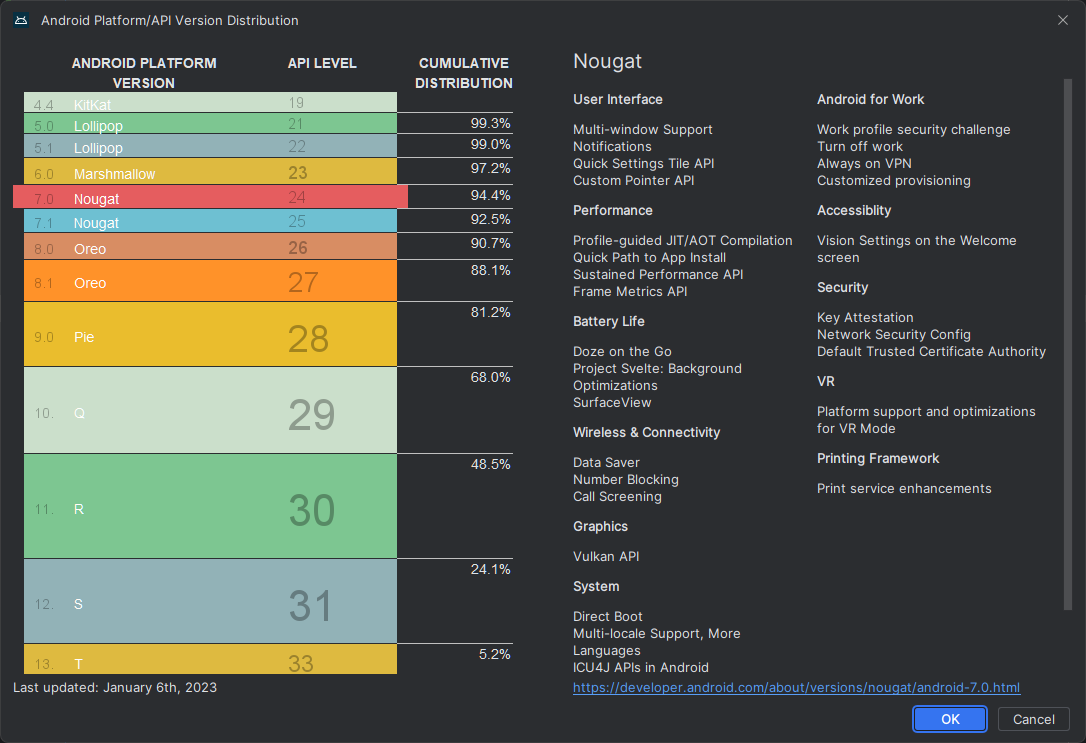Android 13 was rolled out six months ago, and it is now being used by at least 5.2% of Android devices with all things having been considered and taken into account. This is the first usage update that developers have received regarding the latest iteration of the Android operating system, and it shows that adoption rates are picking up.
With all of that having been said and now out of the way, it is important to note that Android 12 has also gotten a significant boost in that period. Back in August, 13.5% of Android devices were using Android 12. That has now increased to 18.9%.
This seems to suggest that older versions of Android that preceded Android 12 are becoming less popular than might have been the case otherwise. For example, Android Oreo just dipped below the 10% mark for the first year in years, with KitKat dropping from 0.9% to 0.7% and Jelly Bean no longer being a part of the list after hitting 0.3% in August.
One thing to mention is that Android 13 is seeing a really fast adoption rate. This is partly due to major Android OEMs such as Google, Samsung and OnePlus rolling the updates out as fast as possible.
Factoring in adoption rates for Android version is essential because of the fact that this is the sort of thing that could potentially end up highlighting what the user experience currently looks like. It seems like a lot of users are jumping on the Android 13 bandwagon, and that might make it grow faster than might have been the case otherwise.
However, this data also shows that older versions of Android still hold a lot of sway. The most popular version of Android continues to be Android 12, which makes sense since the next to latest version of an operating system generally tends to be the most popular one until something new comes along. Users generally stick with what they are familiar with, and that currently happens to be Android 12 although that might change in the near future thanks to Android 13’s rapid rise.
H/T: 9to5Google
Read next: Researchers Warn Against A Massive Number Of Apps Carrying Security Flaws In Their First Year Of Existence
With all of that having been said and now out of the way, it is important to note that Android 12 has also gotten a significant boost in that period. Back in August, 13.5% of Android devices were using Android 12. That has now increased to 18.9%.
This seems to suggest that older versions of Android that preceded Android 12 are becoming less popular than might have been the case otherwise. For example, Android Oreo just dipped below the 10% mark for the first year in years, with KitKat dropping from 0.9% to 0.7% and Jelly Bean no longer being a part of the list after hitting 0.3% in August.
One thing to mention is that Android 13 is seeing a really fast adoption rate. This is partly due to major Android OEMs such as Google, Samsung and OnePlus rolling the updates out as fast as possible.
Factoring in adoption rates for Android version is essential because of the fact that this is the sort of thing that could potentially end up highlighting what the user experience currently looks like. It seems like a lot of users are jumping on the Android 13 bandwagon, and that might make it grow faster than might have been the case otherwise.
However, this data also shows that older versions of Android still hold a lot of sway. The most popular version of Android continues to be Android 12, which makes sense since the next to latest version of an operating system generally tends to be the most popular one until something new comes along. Users generally stick with what they are familiar with, and that currently happens to be Android 12 although that might change in the near future thanks to Android 13’s rapid rise.
H/T: 9to5Google
Read next: Researchers Warn Against A Massive Number Of Apps Carrying Security Flaws In Their First Year Of Existence


